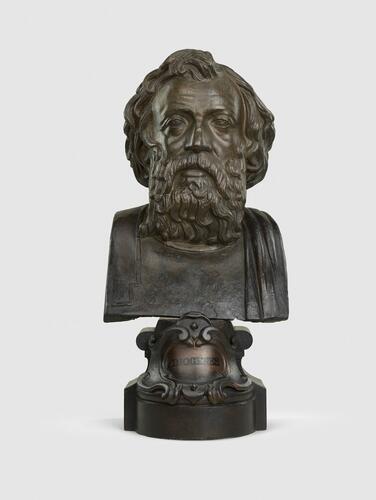-
1 of 253523 objects
Diogenes (412 or 414 - 323BC) c.1636-7
Bronze, plaster, sandstone, iron | 63.0 cm (including base/stand) | RCIN 1324
-
A bronze bust of the Ancient Greek philosopher Diogenes, depicted in late middle-age with slightly receding longer hair, trimmed moustache and beard, and with drapery over his left shoulder. The base has a cartouche to the front which contains the subject's name. The subject wears a breastplate, with a shoulder strap at the right shoulder and drapery over the left. The cartouche is attached with a domed bolt at top and bottom. The outer areas of the strapwork finished with punching. The centre of the cartouche is inscribed in paint: DIOGENES. Prototype: a bust of ‘Lykourgos’ formerly in the Farnese Collection (Naples, Museo Archaeologico Nazionale, inv. 6132).
One of a series of fifteen busts (twelve of which survive) supplied to Charles I by Hubert Le Sueur. They can be characterised as generalised or ‘improved’ copies of ancient busts rather than direct casts of their various prototypes. The ancient prototypes were all in the Farnese collection in Rome at the time the moulds were obtained in around 1635, and today are in the Museo Archaeologico, Naples.
In many cases the proportions of the busts and the arrangement of drapery have been modified by the use of plaster, presumably in the interest of creating a uniform series from a disparate set of originals.The variations between Le Sueur’s busts and their ancient prototypes were necessary because his task was to make a set from a group of heads that were not themselves made by the same sculptor or strictly in the same style. In addition, the ancient marble busts were not the only source available to him. Engravings of at least six of the busts were published in Ioannes Faber’s compendium Illustrium Imagines exantiquis marmoribus of 1606 based on the Imagines et elogia virorum illustrium et eruditor (1570) by Fulvio Orsini, librarian to the Farnese, a pioneering and influential study of ancient iconography.
Nine of the twelve busts are wrongly identified by the labels on their socles. In some cases this may result from the detachment and re-attachment of the socles during one of their many movements, but it is equally likely that neither Le Sueur nor the writer of the inscriptions knew who the busts represented.
Le Sueur’s busts are probably the earliest surviving example in Britain of a set of heads of ancient ‘philosophers’, a term that embraced also historians, poets and orators. Such sets can be found in a number of continental palaces from the early seventeenth century. For example, seven bronze heads (called Seneca, Solon, Marcellus, Diogenes, Plato, Socrates and Demosthenes), described a ‘cast after the antique,’ were listed in 1643 in the petite Galerie of Cardinal Richelieu’s palace in in Paris, and a series of bronze philosophers was also included in the posthumous inventory of the collection of his successor Cardinal Jules Mazarin (1602–61). A group of four bronze busts derived from the same Farnese prototypes (and more faithful to them), which are thought to date from the early seventeenth century, were in the ducal collections at Braunschweig. Perhaps of most relevance here is the set of nine bronze heads of ‘philosophers’ listed in the posthumous inventory of the Paris hôtel of Louis Phélypeaux de la Vrillière (1598–1681). Although we do not know their identities, it is perhaps significant that de la Vrillière became an important patron of Hubert Le Sueur following his return to France in 1641. The fashion for series of busts of this kind, some of which mixed ancient and modern celebrities, hit Britain more generally in the early eighteenth century.
The first setting for Le Sueur’s busts in St James’s Palace is not known. Just under half of them are recognisable from several sheets of drawings compiled for inventory purposes during the seventeenth century (RCIN 970148). By the end of the century many of the busts seem to have found their way into William III’s library at Kensington Palace. Here they may have been placed on tall glazed bookcases, an arrangement seen in an engraving by Daniel Marot of William’s Library at his Dutch Palace, Het Loo, dating from around 1712. The busts were moved from Kensington to Buckingham House in 1821, presumably as part of a more general accumulation of works of art intended for the new Palace. They can next be located with certainty when they were moved from store at St James’s Palace to Windsor Castle in 1834. However they do not appear in the inventory of bronzes taken at Windsor in 1875. In 1916, Queen Mary recommended that vacant positions in the Cupola Room at Kensington Palace be filled by six of the Le Sueur philosophers. In 1974 it was decided that the set of original Le Sueur bronzes should be reunited and that the high positions in the Cupola Room could be filled with casts. These were made by J.P. Langhorn for the British Museum plaster workshop.
Text adapted from Sculpture in the Collection of His Majesty The King (2025)
Provenance
Acquired by Charles I, c.1636–7. Invoice for £30 each reduced by Charles I to £24 per bust.
St James’s Palace; ? sold in the Commonwealth sales of 1651; ? Whitehall Palace; Kensington Palace, King’s Library; twelve busts sent to Buckingham Palace, 1821; St James’s Palace; ten busts sent to Windsor Castle in 1834; Buckingham Palace, Lower Corridor (all twelve busts); Kensington Palace, store; Hampton Court Palace, Lower Orangery (from 1974). -
Creator(s)
(nationality)Acquirer(s)
-
Medium and techniques
Bronze, plaster, sandstone, iron
Measurements
63.0 cm (including base/stand)
44.5 cm (excluding base/stand)

